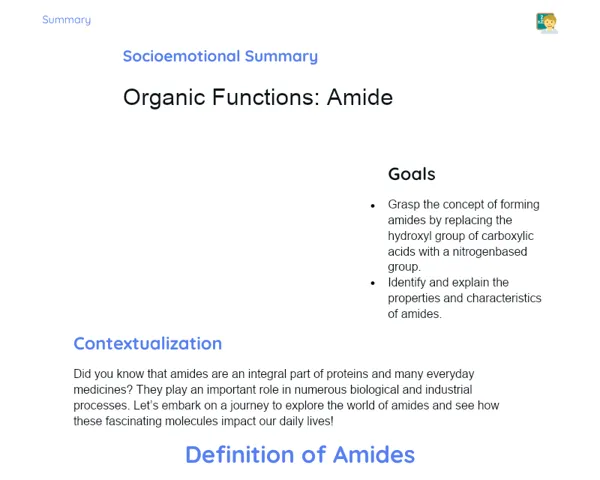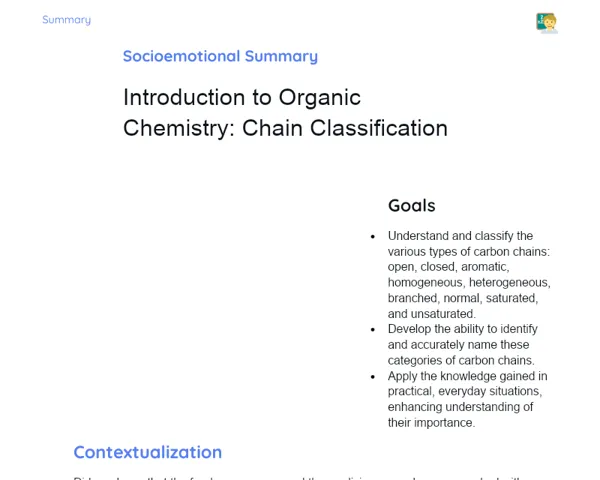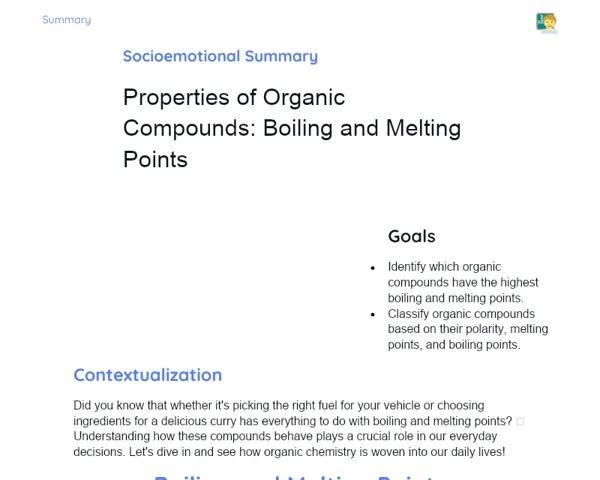Summary Tradisional | Organic Functions: Organic Functions Problems
Contextualization
Organic Chemistry is a vital branch of chemistry that focuses on carbon compounds, which are fundamental to all life forms. In this field, functional groups play a key role as specific groups of atoms that grant distinct chemical and physical properties to molecules. Among these functional groups are alcohols, amines, and ethers, each exhibiting unique characteristics and reactivities. A solid grasp of these functions is essential for analyzing and applying organic compounds across various fields such as healthcare, industry, and biotechnology.
Alcohols contain a hydroxyl group (-OH) attached to a saturated carbon atom and are extensively used in beverages, cleaning agents, and pharmaceuticals. Amines originate from ammonia (NH₃) where one or more hydrogen atoms are swapped with alkyl or aryl groups, often found in neurotransmitters and medicines. Ethers consist of an oxygen atom connected to two alkyl or aryl groups and find their use as solvents, and were historically employed as anesthetics. A thorough understanding of their structure, naming conventions, and properties is critical for tackling challenges related to organic functions and their real-world applications.
To Remember!
Alcohols
Alcohols are organic compounds characterized by one or more hydroxyl groups (-OH) attached to their saturated carbon atoms. Their general formula is R-OH, where R denotes an alkyl or aryl group. Common examples include methanol (CH₃OH) and ethanol (C₂H₅OH). The presence of the hydroxyl group imparts unique physical and chemical traits, such as the ability to form hydrogen bonds, enhancing their solubility in water and raising their boiling points relative to other compounds of similar molecular weight.
The nomenclature of alcohols adheres to IUPAC rules. The longest carbon chain that contains the -OH group is considered the main chain, and the carbon atoms are numbered to ensure the hydroxyl group has the lowest possible number. The suffix '-ol' is then added to the name of the corresponding alkane. For instance, ethanol consists of a two-carbon chain with one -OH group, while propanol has three carbons.
Alcohols typically have high boiling points due to hydrogen bonding and are generally soluble in water, especially those of lower molecular weight. Chemically, they can undergo oxidation reactions; primary alcohols can be oxidized to form aldehydes and further to carboxylic acids, while secondary alcohols are turned into ketones. However, tertiary alcohols resist oxidation.
The practical applications of alcohols are extensive. Ethanol is used in alcoholic beverages, as a solvent in industrial and laboratory settings, and as a fuel. Methanol serves as an industrial solvent and antifreeze, though it's toxic if ingested.
-
General formula: R-OH
-
Nomenclature follows IUPAC conventions
-
High boiling points due to hydrogen bonding
-
Increased solubility in water for lower molecular weight alcohols
-
Oxidation reactions of primary and secondary alcohols
Amines
Amines are organic compounds derived from ammonia (NH₃), where one or more hydrogen atoms are replaced by alkyl or aryl groups. They are categorized as primary (R-NH₂), secondary (R₂NH), and tertiary (R₃N) based on the number of substituents on the nitrogen atom. Examples include methylamine (CH₃NH₂) as a primary amine and dimethylamine (CH₃NHCH₃) as a secondary amine.
The naming of amines is determined by which hydrogen atoms of ammonia have been substituted. Primary amines receive the suffix '-amine' added to the name of the corresponding alkyl group, for instance, methylamine. For secondary and tertiary amines, the alkyl groups are listed in alphabetical order followed by '-amine', such as diethylamine and triethylamine.
Compared to alcohols, amines have lower boiling points but higher than hydrocarbons of similar molecular weight due to intermolecular hydrogen bonding. They are soluble in water, especially those of lower molecular weight. Chemically, amines exhibit basic properties and can react with acids to form ammonium salts, like the neutralization of an amine with hydrochloric acid: CH₃NH₂ + HCl → CH₃NH₃⁺Cl⁻, yielding methylammonium chloride.
Amines are significant in numerous biological and industrial contexts. They are crucial components of neurotransmitters like serotonin and dopamine, and are employed in the production of medications, dyes, and polymers.
-
General formula: R-NH₂, R₂NH, or R₃N
-
Nomenclature based on hydrogen atom substitution from ammonia
-
Intermediate boiling points due to hydrogen bonding
-
Enhanced water solubility for low molecular weight amines
-
Basic behavior when reacting with acids to yield ammonium salts
Ethers
Ethers are organic compounds where an oxygen atom is bonded to two alkyl or aryl groups. Their general formula is R-O-R', where R and R' may either be identical or different. Prominent examples of ethers include diethyl ether (C₂H₅-O-C₂H₅) and dimethyl ether (CH₃-O-CH₃). Ethers are noted for their low polarity and volatility.
The nomenclature of ethers can be approached in two ways. In common nomenclature, the alkyl or aryl groups linked to the oxygen are arranged alphabetically, followed by 'ether', such as ethyl ether. In IUPAC nomenclature, the smaller group is treated as a substituent on the larger group, with '-oxy' appended to the name of the larger group, for instance, methoxyethane.
In terms of physical properties, ethers possess relatively lower boiling points due to the lack of intermolecular hydrogen bonding, which makes them more volatile when compared to similar-sized alcohols. They are moderately soluble in water and serve as excellent solvents for a wide array of organic substances. Chemically, ethers demonstrate relative inertness, which renders them valuable as solvents in various chemical reactions.
Ethers have numerous practical uses. Diethyl ether was historically applied as a general anesthetic due to its volatility and rapid unconsciousness-inducing properties. Today, ethers are commonly utilized as solvents in laboratories and industries owing to their stability and effectiveness in dissolving diverse substances.
-
General formula: R-O-R'
-
Options for common and IUPAC nomenclature
-
Low polarity and high volatility
-
Low boiling points due to lack of hydrogen bonding
-
Chemical inertness enhances their solvent capabilities
Key Terms
-
Functional Groups: Specific groups of atoms that impart characteristic chemical and physical properties to organic molecules.
-
Alcohol: Organic compound containing one or more hydroxyl groups (-OH) attached to saturated carbon atoms.
-
Amine: Organic compound originating from ammonia, with substitution of one or more hydrogen atoms by alkyl or aryl groups.
-
Ether: Organic compound consisting of an oxygen atom bonded to two alkyl or aryl groups.
-
IUPAC Nomenclature: Chemical naming system established by the International Union of Pure and Applied Chemistry for naming chemical compounds.
-
Hydroxyl Group: Functional group -OH found in alcohols.
-
Alkyl Group: Functional group derived from an alkane by removing a hydrogen atom.
-
Aryl Group: Functional group derived from an aromatic ring by removing a hydrogen atom.
-
Hydrogen Bonds: Strong intermolecular attractions between hydrogen atoms and electronegative atoms like oxygen or nitrogen.
-
Boiling Point: Temperature at which a liquid transforms into a gaseous state.
-
Solubility: Capacity of a substance to dissolve in a solvent.
Important Conclusions
In this lesson, we delved into the organic functions of alcohols, amines, and ethers. We examined their structures, IUPAC naming conventions, physical and chemical properties, and distinctive reactions. A proper understanding of these compounds is essential for numerous practical applications, from crafting cleaning agents to synthesizing medications and industrial solvents.
We particularly emphasized the ability of alcohols to form hydrogen bonds, which greatly affects their solubility and boiling point properties. Discussions around amines focused on their basicity and response to acids, along with their significance in biological and industrial applications. Ethers, recognized for their low polarity and volatility, were noted for their roles as solvents and historically for their use in anesthesia.
The knowledge gained in this session is fundamental for analyzing and applying organic compounds in diverse fields. We strongly encourage students to actively pursue further investigation into this topic, exploring new reactions and applications of these organic functions in both industrial and biological contexts to enhance their understanding and proficiency in Organic Chemistry.
Study Tips
-
Regularly review the naming rules for organic compounds to reinforce your grasp of the concepts and facilitate compound identification.
-
Practice exercises that involve identifying, classifying, and understanding the properties and reactions of alcohols, amines, and ethers.
-
Keep up with scientific articles and educational resources concerning the practical applications of alcohols, amines, and ethers in industry and healthcare to contextualize theoretical knowledge.



